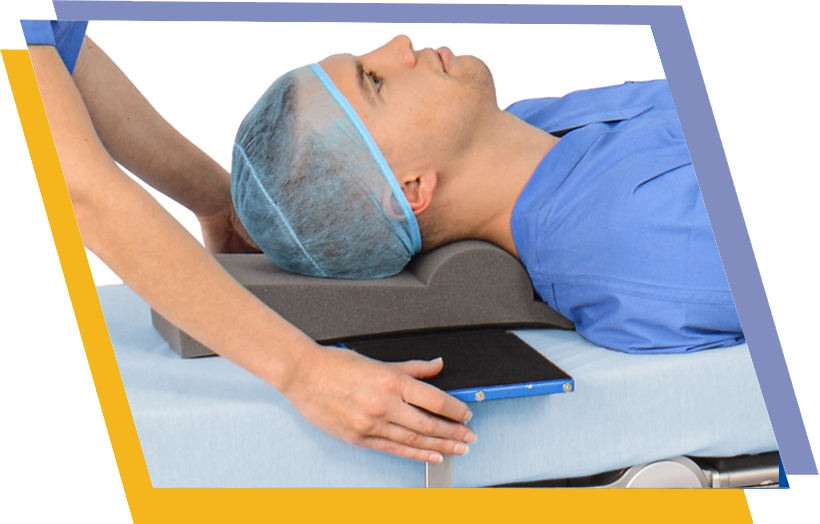Case Study
Nursing Professionals Stories – Nate & Gloria
Two nursing professionals, Nate Sheehan and Gloria Payne, provide first-hand accounts of how TrenGuard® Trendelenburg Patient Restraint from D. A. Surgical is easier for hospital staff to use, is procedurally more efficient, and is safer for patients compared to beanbag positioning systems and tape and foam.


Nate Sheehan, director of nursing at Lafayette Surgery Center in Lafayette, Colorado, first learned about D. A. Surgical TrenGuard when he worked at Lutheran Medical Center in Wheat Ridge, Colorado.
“I was brought on as the clinical coordinator for general surgery, gynecology, urology, robotics, and pediatric dental, and when I was there, I helped to build their bariatrics service line. TrenGuard was already being used there. Prior to that, when I was doing these procedures, I was using a beanbag system.”
From Sheehan’s perspective, D. A. Surgical TrenGuard is more efficient, easier to use, and safer than traditional beanbag systems.
Expand the sections below for details.
Easier to Use
Sheehan explains how D. A. Surgical TrenGuard compares to old-style beanbag positioning: “With the beanbag, you’re supposed to take the beanbag off the bed between patients for cleaning, and it has three straps on it, and it straps down to the bed, and you have to make sure the straps are positioned a certain way on the side rails of the O.R. table. So, each side rail attaches to the bed in spots. When you’re positioning your straps, you have to make sure it’s between two of the attachment points to the O.R. table, so that if there is any sliding, which there shouldn’t be, but if there is sliding, those straps don’t slide past that point.”
“I would say TrenGuard is a more complete system, and why I say that is because of the additional supplies you need for the beanbag positioner. You need extra foam in certain places because the patient is lying on a hard, lumpy surface.”
More Efficient
According to Sheehan, D. A. Surgical TrenGuard is “better from an efficiency standpoint” compared to traditional beanbag positioning, which requires more complex setup procedures and disassembly protocols. TrenGuard has allowed for a reduction in room turnover time.
Earlier in his career, Sheehan was recruited by St. Anthony’s Hospital in Colorado to “build their robotic surgery program from scratch.” He explains how D. A. Surgical TrenGuard allowed him to increase efficiency: “One of the first things I did when I got there was bring in TrenGuard because we were trying to entice our surgeons to bring in more cases.”
After Sheehan implemented process flow changes at St. Anthony’s, he says, “All our service lines had less than 30-minute turnovers, except for urology.” There, the turnover times were about 50 minutes. “We switched out the beanbag system they were using, and we implemented TrenGuard, and turnovers got down to about 27 minutes.”
In addition, Sheehan notes that D. A. Surgical TrenGuard is deployable with only two people, while the traditional beanbag system requires a minimum of four.
Safer for Patients
Sheehan explains how D. A. Surgical TrenGuard is safer than traditional beanbag positioning systems: “One thing we learned in nursing school that is drilled into us is the formula ‘pressure over time kills cells.’ That’s how you end up with pressure injury. Pressure over a significant amount of time can start to kill nerve cells, which can cause pain and failure of those nerves, so you wind up with people waking up with drop foot or numbness down the outside of their arm, and they sometimes never get that sensation back.”
“The thing about the beanbag technology is that you have to get all the little beads that are in there distributed evenly throughout the beanbag so that when the suction comes on, those beans get sucked together, and that’s what prevents the patient from moving. It’s never completely stiff, so multiple times using this, we’ve essentially had to reflate the beanbag, position beans again, and then suck that air back out—especially in the head and neck region. We push the beanbag into place and then when the air gets sucked out, we find that there aren’t enough beads there, and it slackens and loosens. So, you end up with the shoulder, one side, especially, shrugging towards the ears.”
“That is completely eliminated with TrenGuard. You have the frame that attaches to the bed, you place that speed bump, and then the cradle for the head, and then you get the shoulders positioned, which prevents that shrugging motion, so the patient is always in that neutral position—doesn’t matter if they’re at five degrees Trendelenburg or 35 degrees Trendelenburg—they still maintain that neutral position.”
- Patients cannot slide
- No shoulder braces to create pressure on nerve tissue
- Accommodates high BMI
Testimonial
Gloria Payne, who works at a 632–bed hospital in Michigan, has personal experience with D. A. Surgical TrenGuard both as a nurse and as a patient:
As a nurse:
One of our surgeons wanted to try TrenGuard because we have a high clientele of patients with high BMI. Our very first case with TrenGuard was a 400-something-pound woman—so high BMI, large patients.
We got comfortable with TrenGuard, especially for large patients. One of our other surgeons was very particular about positioning. He was afraid a patient might slide off the bed or experience nerve damage. So, we just started using TrenGuard because of how confident we became in it. With other means that we used, the patient would slide.
He was using it for a good year before he came up to me and said, “Gloria, I was at such-and-such, and they had this new product, and it’s called TrenGuard.” And I kind of looked at him and said, “Yeah?” And he said, “That’s what I want to use from now on with my patients that slide.” And I said, “Well, did you ever think that your patients stopped sliding about a year ago?” He kind of looked at me, and I said, “We’ve been using TrenGuard for a year, and you haven’t noticed.” Luckily, I had a good rapport with the surgeon [chuckling]. He just kind of looked at me, and I said, “You’re welcome. That’s what I’m here for.”
That’s how confident we became in TrenGuard. And this was a surgeon who
could have gotten upset very quickly as he was very particular about his positioning.
We went from a good seven- to ten-minute positioning process, with tape and foam, to where it can probably be done in under two minutes now.

As a patient:
When I had to have surgery, I was a little bit heavier because of health complications. I had two previous sprains in my neck and in my right shoulder, so I was kind of worried about being put in Trendelenburg. I was tipped for a good three hours and had no problems at all. None. We use TrenGuard for patients, so we know that it’s a good product. I still had a little concern, with my injuries, but even after over three hours in surgery with TrenGuard I had no numbness, no tingling, nothing.
Want to see the powerful difference our products can make for your procedures?
Just complete the form below.
